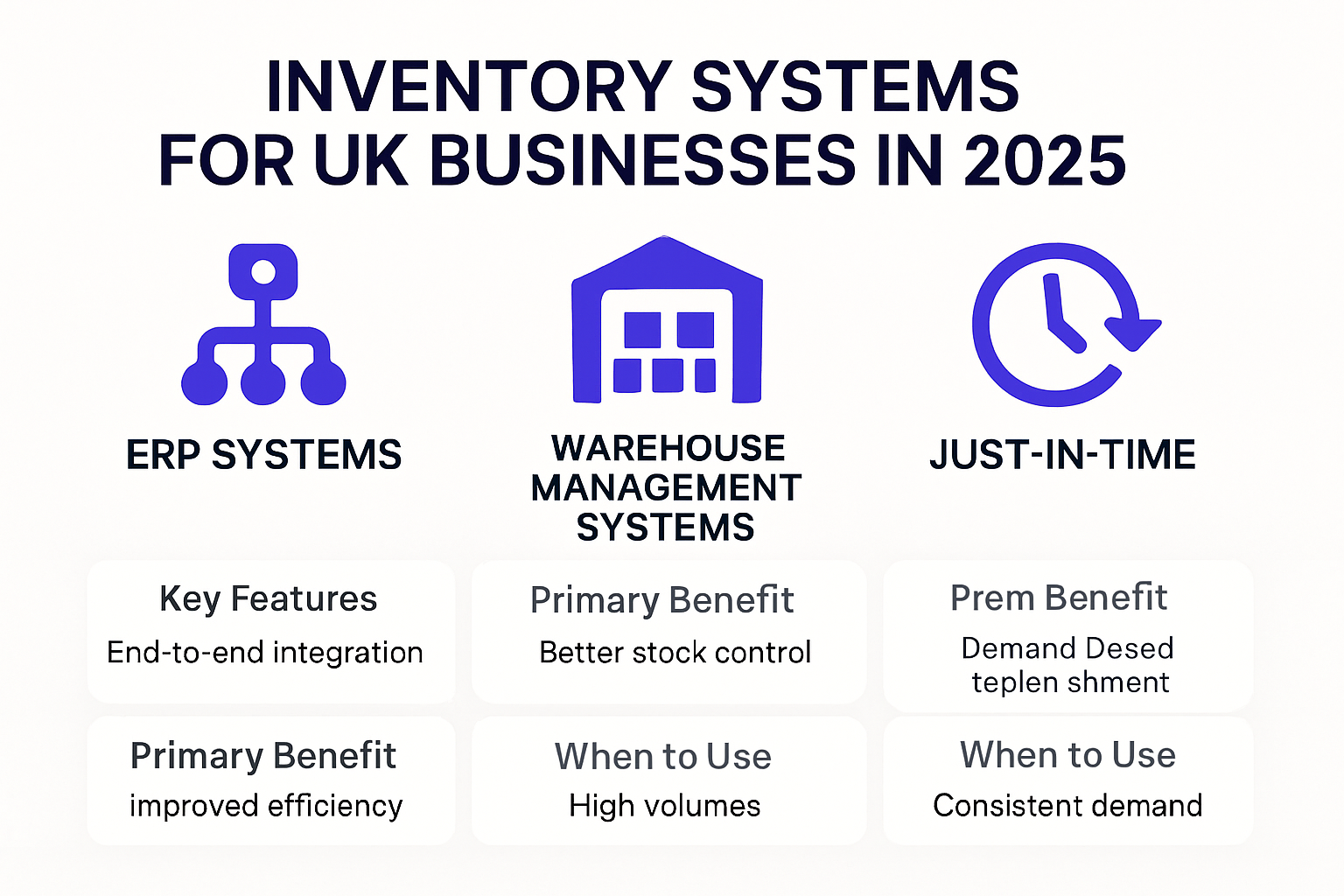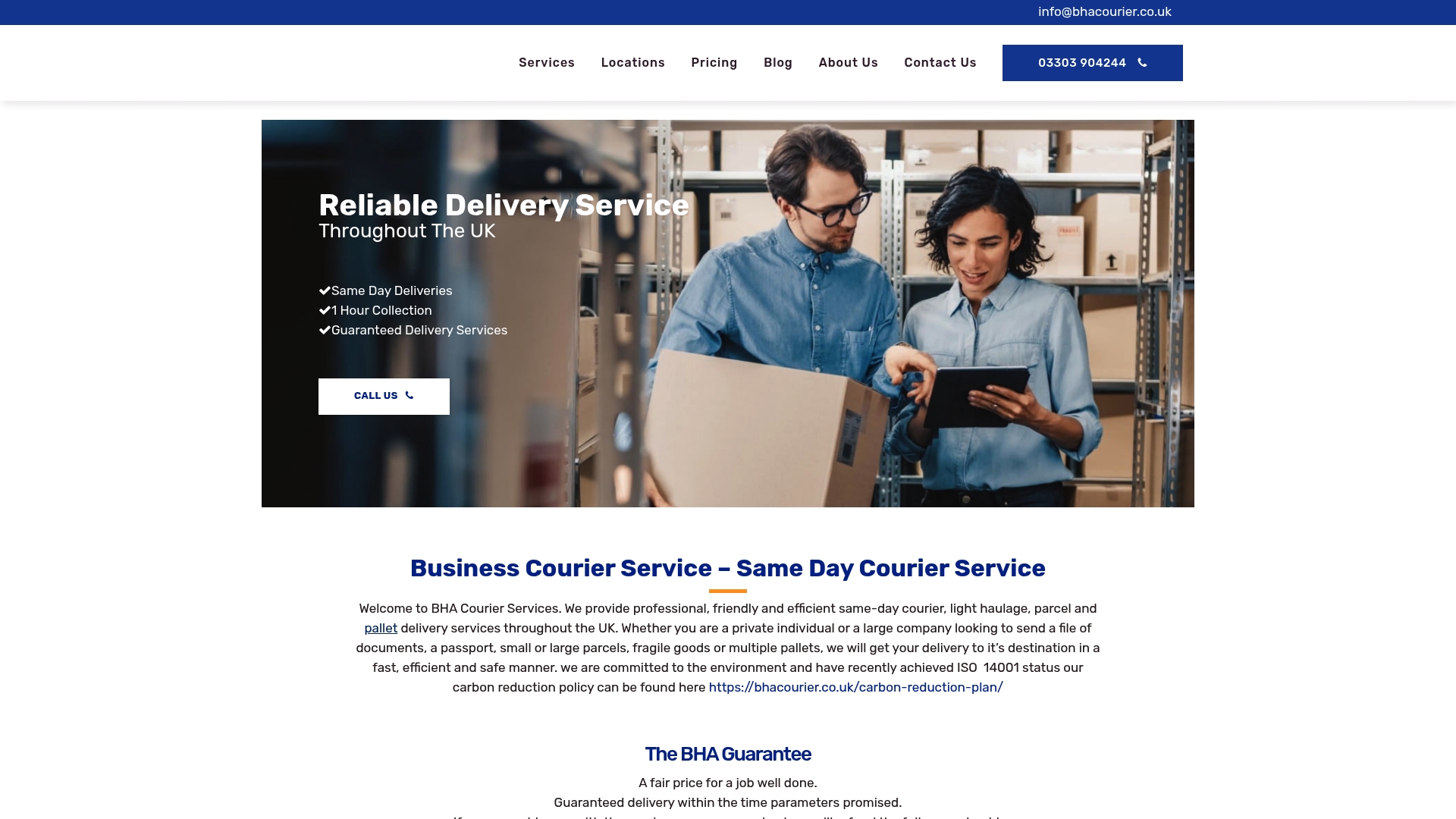
08 Aug Inventory Management Basics for UK Businesses 2025
Stock sitting on your shelves can make or break your business. The difference between smooth sailing and chaos often comes down to efficient inventory management. But here is something most people overlook. Advanced inventory management systems can slash operational costs by up to 25 percent for UK small and medium enterprises. So before you reach for those old spreadsheets, it is the overlooked tech and strategy upgrades that are quietly shaping the most competitive businesses in 2025.
Table of Contents
- Understanding Inventory Management Basics
- Common Inventory Systems For UK Businesses
- Best Practices For Efficient Stock Control
- How To Choose Tools For Your Business Needs
Quick Summary
| Takeaway | Explanation |
|---|---|
| Master core inventory principles | Balance supply and demand while minimizing costs for effective stock management. |
| Leverage technology for efficiency | Utilize digital systems with AI for real-time tracking and predictive analytics. |
| Implement regular inventory audits | Conduct periodic counts to ensure accuracy and prevent discrepancies in stock records. |
| Classify inventory strategically | Use methods like ABC analysis to prioritize stock based on value and importance. |
| Select tools tailored to specific needs | Assess requirements carefully to choose inventory management tools that fit your business size and complexity. |
Understanding Inventory Management Basics
Inventory management is the strategic process of ordering, storing, and tracking a company’s goods to ensure optimal stock levels and operational efficiency. For UK businesses in 2025, mastering inventory management basics is crucial for maintaining competitive advantage and financial stability.
The Core Principles of Inventory Control
At its fundamental level, inventory management involves balancing supply and demand while minimising unnecessary costs. Businesses must track precise quantities of products, understand their stock movement patterns, and develop systems that prevent both overstocking and stockouts. The Chartered Institute of Procurement & Supply suggests that effective inventory management can reduce operational costs by up to 25% for small and medium enterprises.
Successful inventory management requires businesses to implement robust tracking mechanisms. This involves using technologies and methodologies that provide real-time insights into stock levels, product performance, and potential supply chain disruptions. Modern businesses are increasingly turning to digital solutions that offer comprehensive visibility and predictive analytics.
Technological Innovations in Inventory Tracking
The landscape of inventory management has transformed dramatically with technological advancements. Gartner Research reports that businesses using advanced inventory management technologies can reduce inventory holding costs by 20-30% while improving overall operational efficiency.
Digital inventory management systems now incorporate artificial intelligence and machine learning algorithms that can predict demand, identify potential stock issues, and recommend optimal reordering strategies. These systems go beyond traditional spreadsheet tracking, offering businesses dynamic, real-time insights that support strategic decision making.
Financial Implications of Effective Inventory Management
Proper inventory management directly impacts a company’s financial health. Inefficient stock control can lead to significant financial losses through excess stock, expired products, or missed sales opportunities. By maintaining optimal inventory levels, businesses can improve cash flow, reduce storage costs, and enhance their ability to respond quickly to market changes.
UK businesses must view inventory management not just as an operational necessity, but as a strategic tool for growth. The ability to accurately forecast demand, manage supplier relationships, and maintain lean inventory levels can provide a substantial competitive advantage in an increasingly dynamic marketplace.
For businesses looking to refine their inventory management approach, investing in training, technology, and continuous improvement processes is essential. By embracing modern inventory management basics, companies can transform a traditionally administrative function into a strategic asset that drives business performance and profitability.
Common Inventory Systems for UK Businesses
Inventory systems are critical technological frameworks that enable businesses to track, manage, and optimise their stock levels efficiently. For UK businesses in 2025, selecting the right inventory management system can significantly impact operational performance and financial outcomes.
Enterprise Resource Planning Systems
Enterprise Resource Planning (ERP) systems represent a comprehensive approach to inventory management. According to research from the University of Cambridge, ERP solutions integrate multiple business processes, providing seamless inventory tracking across different departments. These systems offer real-time visibility into stock levels, automate reordering processes, and generate detailed analytical reports that support strategic decision making.
Businesses can leverage ERP systems to synchronise inventory data across multiple locations, track product movements, and predict future stock requirements. The advanced analytics capabilities enable companies to identify trends, reduce waste, and optimise procurement strategies. UK government research indicates that medium to large enterprises extensively use these systems to enhance operational efficiency.
Warehouse Management Systems
Warehouse Management Systems (WMS) are specialised inventory tracking solutions designed to manage complex warehouse operations. These systems provide granular control over stock placement, picking processes, and inventory movement. Micro and small businesses can benefit from WMS technologies that offer real-time tracking, reduce manual errors, and improve overall warehouse productivity.
Modern WMS solutions incorporate advanced features such as barcode scanning, RFID technology, and automated inventory counting. These technologies enable businesses to maintain accurate stock records, minimise physical inventory checks, and streamline order fulfillment processes. By implementing a robust WMS, companies can reduce operational costs and improve customer satisfaction through faster, more accurate order processing.
Just-In-Time Inventory Management Systems
Just-In-Time (JIT) inventory management represents a strategic approach that focuses on minimising stock holding costs while maintaining optimal product availability. Our comprehensive guide on JIT delivery explores how businesses can implement this lean inventory strategy to reduce waste and improve cash flow.
JIT systems require precise demand forecasting and strong supplier relationships. By ordering stock only when needed, businesses can reduce storage expenses, minimise the risk of product obsolescence, and maintain a more agile supply chain. This approach is particularly beneficial for industries with rapidly changing product lines or high-value inventory.
Selecting the appropriate inventory system depends on various factors, including business size, industry complexity, and specific operational requirements. UK businesses must carefully evaluate their needs, consider implementation costs, and choose a system that provides scalability and adaptability in an increasingly dynamic marketplace.
To help UK businesses easily compare the main types of inventory management systems discussed, the following table summarises each system’s features, typical users, and key benefits:
| Inventory System Type | Key Features | Typical Users | Key Benefits |
|---|---|---|---|
| ERP Systems | Integrates all business processes; real-time data | Medium & large enterprises | Streamlined operations, data visibility |
| Warehouse Management Systems (WMS) | Warehouse-specific controls; barcode/RFID support | Micro & small businesses | Accurate stock, reduced errors |
| Just-In-Time (JIT) Systems | Orders stock as needed; demand-driven | Agile, fast-moving sectors | Minimised holding costs, reduced waste |

Implementing an advanced inventory management system is not just a technological upgrade but a strategic investment in operational excellence. By embracing these innovative solutions, businesses can transform their inventory management from a traditional administrative function into a powerful competitive advantage.
Best Practices for Efficient Stock Control
Efficient stock control is a critical component of successful inventory management for UK businesses in 2025. By implementing strategic practices, companies can optimise their inventory processes, reduce costs, and improve overall operational performance.
Inventory Classification and Prioritisation
According to TechTarget, businesses should develop a robust inventory classification system that prioritises stock based on its strategic importance and value. The ABC analysis method provides a systematic approach to categorising inventory, helping businesses allocate resources more effectively.
In this approach, products are divided into three categories:
- A Items: High-value products with significant financial impact
- B Items: Moderate value and moderate consumption
- C Items: Low-value products with minimal financial impact
By understanding the strategic importance of different inventory items, businesses can develop targeted management strategies that optimise stock levels and reduce unnecessary holding costs.
Demand Forecasting and Safety Stock Management
Epicor highlights the importance of precise demand forecasting as a critical best practice for efficient stock control. Advanced forecasting techniques leverage historical data, market trends, and predictive analytics to anticipate future inventory requirements.
Safety stock management plays a crucial role in maintaining operational continuity. By establishing appropriate buffer stock levels, businesses can mitigate risks associated with supply chain disruptions, unexpected demand spikes, and potential delivery delays. Learn more about streamlining your supply chain to enhance your inventory management strategy.
Regular Auditing and Technology Integration
Intact Software emphasises the significance of regular inventory auditing as a key best practice for maintaining accurate stock records. Physical inventory counts should be conducted periodically to reconcile digital inventory records with actual stock levels, identifying and addressing discrepancies promptly.
Modern businesses must also embrace technological solutions that enhance stock control efficiency. Implementing advanced inventory management software, integrating barcode or RFID tracking systems, and utilizing real-time data analytics can significantly improve inventory accuracy and operational visibility.
The First In, First Out (FIFO) method is another critical practice, particularly for businesses dealing with perishable or time-sensitive products. This approach ensures that older stock is sold or used first, minimising the risk of product expiration and reducing potential waste.
Successful stock control is not a one-time effort but a continuous process of monitoring, analyzing, and adapting. UK businesses must remain agile, continuously refining their inventory management strategies to respond to changing market conditions, technological advancements, and evolving customer demands.
By embracing these best practices, businesses can transform their stock control from a routine administrative task into a strategic advantage that drives efficiency, reduces costs, and supports sustainable growth in an increasingly competitive marketplace.
How to Choose Tools for Your Business Needs
Selecting the right inventory management tools is a critical decision for UK businesses in 2025. The complexity of modern supply chains requires a strategic approach to tool selection that goes beyond basic functionality and considers the unique requirements of each organisation.
Assessing Business-Specific Requirements
Multiple-criteria decision analysis (MCDA) provides a sophisticated framework for evaluating inventory management tools by considering multiple conflicting criteria simultaneously. Businesses must conduct a comprehensive assessment of their operational needs, taking into account factors such as company size, industry sector, product complexity, and growth projections.
Key considerations in tool selection include:
- Scalability: The ability to accommodate future business growth
- Integration Capabilities: Seamless connection with existing business systems
- User-Friendliness: Intuitive interfaces that require minimal training
- Reporting and Analytics: Advanced data insights and customisable reporting features
Companies should develop a detailed evaluation matrix that ranks potential tools against these critical parameters, ensuring a methodical approach to selection.
Cost-Benefit and Technological Compatibility
Research from the generic framework for retail inventory management emphasises the importance of holistic tool evaluation. Beyond immediate cost considerations, businesses must analyse the long-term value proposition of inventory management solutions.
This involves examining:
- Initial implementation costs
- Ongoing maintenance expenses
- Potential efficiency gains
- Reduction in operational errors
- Potential for improved customer satisfaction
Discover more about optimising your business communication channels to support your inventory management strategy effectively.
Advanced Selection Methodologies
The Fuzzy Analytic Hierarchy Process (AHP) offers a sophisticated approach to tool selection by addressing the inherent uncertainty in decision making. This methodology allows businesses to quantify subjective assessments and create a more nuanced evaluation process.
Businesses should consider a phased approach to tool selection:
For readers looking to adopt a structured approach to selecting inventory management tools, here is a step-by-step breakdown of the recommended process mentioned in the article:
| Step | Action | Purpose |
|---|---|---|
| 1 | Conduct comprehensive needs assessment | Identify business requirements |
| 2 | Research available solutions | Explore options that fit business context |
| 3 | Create shortlist of potential tools | Narrow down suitable choices |
| 4 | Perform detailed comparative analysis | Evaluate strengths and weaknesses |
| 5 | Consider pilot testing before full implementation | Test performance in real-world setting |
| 6 | Plan ongoing evaluation and system upgrades | Ensure continued effectiveness over time |
- Conduct a comprehensive needs assessment
- Research available solutions
- Create a shortlist of potential tools
- Perform detailed comparative analysis
- Consider pilot testing before full implementation
- Plan for ongoing evaluation and potential system upgrades
Modern inventory management tools should offer more than basic tracking capabilities. Look for solutions that provide predictive analytics, artificial intelligence-driven insights, and real-time monitoring capabilities.
Ultimately, the most suitable inventory management tool is one that aligns perfectly with your business’s unique operational landscape. It should not only address current challenges but also provide flexibility to adapt to future technological advancements and market changes.
By approaching tool selection as a strategic investment rather than a mere technological purchase, UK businesses can transform their inventory management from a routine operational function into a powerful competitive advantage.

Frequently Asked Questions
What are the core principles of inventory management?
The core principles of inventory management involve balancing supply and demand while minimising costs. This includes tracking product quantities, understanding stock movement, and developing systems to prevent overstocking and stockouts.
How can technology improve inventory management for UK businesses?
Technology can significantly enhance inventory management by providing real-time tracking, predictive analytics, and automated processes. Advanced systems use AI and machine learning to forecast demand and streamline inventory control, reducing operational costs and improving efficiency.
What is the importance of conducting regular inventory audits?
Regular inventory audits are crucial for maintaining accurate stock records and identifying discrepancies between actual stock and digital records. This practice helps businesses ensure optimal stock levels, reduce losses, and improve overall accuracy in inventory management.
How do I choose the right inventory management tools for my business?
To choose the right inventory management tools, assess your business-specific requirements, including scalability and integration capabilities. Additionally, consider the cost-benefit analysis and technological compatibility to ensure the selected tools align with your operational needs and future growth.
Transform Stock Control into Competitive Delivery Power
Is your business struggling to keep stock levels in line, or losing valuable time with unreliable delivery partners? The article above highlights how advanced inventory systems can slash costs and keep your shelves balanced, but achieving this efficiency also relies on dependable logistics. A powerful inventory strategy is only as strong as your supply chain. Your critical goods deserve speed, security and reliability with every delivery.

Accelerate your stock management and safeguard your assets by partnering with a courier trusted by UK businesses demanding real-time response. BHA Courier delivers same-day and next-day courier services, giving you precise parcel tracking and nationwide reach, so you never face supply disruptions or delayed shipments. Ready to align your supply and delivery for perfect operational flow? Discover the benefits of seamless logistics and book your time-critical delivery today at BHA Courier. Your business should not risk slow or uncertain deliveries when reputation is on the line. Take action now and let our team help you maintain that competitive edge.

Sorry, the comment form is closed at this time.